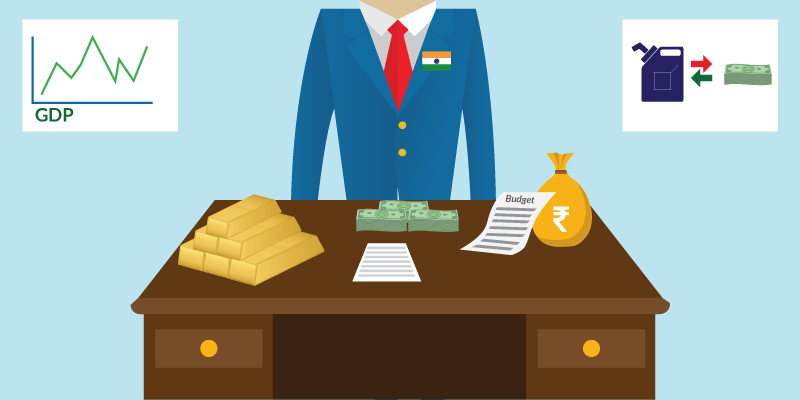If India were a person, its diversity would be confusing indeed. But India has a very specific identity and its habits and behavior can easily be likened to a person. This pertains to its financial behavior as well.
India has seen its fair share of ups and downs in the recent past, in terms of debt and money management. Let’s see how India, if it were an individual, has fared in managing its finances in the recent past.
Income and expense
The budget, whether it is the monthly budget of an individual or the annual budget of a country, is a good indicator of his/her general financial management skills.
There was a time between 2003-2004 and 2009-2010, when India had managed to keep its budget deficit (excess expenses to earnings) well below 4%. However, in order to shield the country from the adverse impacts of the financial crisis in 2008-09, and the general slump in consumption globally, the government went on a spending spree. They increased the spending in social schemes, such as MNREGA and others, to boost consumption and the GDP growth. It initially yielded positive results, as the country saw the GDP grow in double digits in 2010-11.
However, these excesses (higher spending vis-à-vis revenue growth) also started showing their side-effects as the budget deficit touched 7.5% in 2009-10 from 3.1% in 2008-09. However, thanks to some quick action by the government (budget cut in healthcare and education sector, curbs in gold imports as also fall in crude oil prices), the situation showed drastic improvements as budget deficit stood at 4% of the GDP at the end of 2014-15. This is a sharp improvement from the 4.5% during the previous year.
Trade deficit
Trade deficit is not so much about a country’s lack of financial management skills, than the country’s ability to produce goods and services. For a country like India, the biggest handicap has been lack of crude oil reserves.
Crude oil accounts for more than 30% of the country’s total imports. Therefore, the country’s trade deficit looks alarming as the crude oil prices rise. In fact, from almost no deficit in 2004, the country’s trade deficit has continuously grown and has now touched around $10 billion every month.
India has taken some harsh steps, including imposing high import duty on gold and other measures to discourage gold imports, to check the worsening trade deficit situation.
Debt
Generally, when your expenses are more than your earnings, what would you do? You would take a loan from banks, friends or family members.
The government also borrows from the public and institutions (domestic and foreign) to fund this revenue and expense gap. In case of India, thanks to the high GDP growth rate from 2008-09 to 2010-11, the debt-to-GDP has shown sharp improvement from above 70% between 2001 and 2009-10 to 65.5% in 2013-14.
The country has managed to continuously bring down its debt-to-GDP ratio in the last 10 years except in 2011-12, when it slightly increased from 67.5% to 68.1%.
Savings (forex reserves)
One of the key indicators of an individual’s financial position is his savings—long and short-term. For a country, we can say the forex reserves act as its savings. It can be used for paying debts, imports, as well as for other expenses, like building infrastructure. For two years after 2012, India’s forex reserves remained below $300 billion after touching a high of $320 billion in 2011.
High crude prices and depreciating currency further worsened the situation. However, after 2014, it not only managed to reverse the declining trend, but also saw a healthy growth in forex reserves. By the end of June, the country is at a better perch with forex reserves of $350 billion. This was mainly due to the increased dollar flow into the country through foreign institutional investments and falling imports.
Some experts believe that Indian currency (trading around Rs 64 a dollar) is artificially kept at low levels as the RBI is trying to build a bigger dollar reserve. Many say that the RBI would be comfortable only if it has a forex reserve of $500 dollar.
The verdict
If we have to compare India with an individual, the country is like a person in his early 30s.
He is in the mid-level of his career, and has started creating assets. He needs funds for these assets through loans. At the same time he, needs to ensure that he is managing his debt and finances well so as not to get into a debt trap. And if he realises that he is in some sticky situation, he needs to not only to take harsh steps to cut costs, but also explore other avenues to increase his earnings.
India was in a messy situation from 2011-12 to 2013-14 during which the fiscal deficit increased, debt/GDP ratio went up and GDP growth fell below 5%. But we realised the situation and took necessary and even harsh steps to come out of the fall. Today, when even a behemoth like China is facing crisis, India is among the few who gives hope to the global economy.
The Greece debt crisis was a jolt to every country and it serves as a reminder to everyone, individual or country, to handle their finances right. We have some good lessons to take away from 30 year old India when it comes to finances.
YOU MAY ALSO WANT: Make sure your investment are up to par as well – Compound Interest Calculator
